Let’s talk about the circles…
The so-called circle work is a way to identify the ways we are stuck in our old patterns of thoughts, feelings and beliefs. We stay stuck as long as we continue to use addictive substances and behaviors to soothe our feelings. A huge challenge greets us when we get abstinent from all addictions. And that challenge is to deal with all the stored thoughts and emotions that we never dealt with directly.
Our addictive patterns are wired into the brain…
We come to realize that the work of recovery is to change. What do we change? What we think, what we say, and what we do. It may seem tough to change everything about ourselves but we do it one day at a time, one choice at a time, and one action at a time and in doing so, we change our brains.
Our addictive responses are wired together in our brains…
You may be familiar with the statement regarding the brain that, “Neurons that fire together–wire together.” It means that every experience we have, and the associated feelings, thoughts, physical experiences become carved into our brains. The more an action is repeated, the connection between the neurons becomes stronger. Practice makes permanent! In the disease process, this works to reinforce the thoughts, feelings and behaviors that support addiction. The brain is plastic!! Plasticity is the brain’s ability to be flexible and to rewire in response to experience. We have found that our positive recovery experiences can actually rewire our brains. There are many tools that we can use to do this work: meetings, literature, sponsor contacts, immersion into the twelve steps, and our spiritual practices to name a few.
The circles are another way to deal directly with emotions when they come up by changing the thought that creates them. That’s right! Our thoughts create our feelings. It is the thoughts we think, not the people we blame, that cause our anger, fears and guilt.

Here is how the circles work:
1) Identify the Present Feeling: What’s the feeling? Be sure it is one word: sad, glad, hurt, angry, guilty. We do the feeling first because it is the messenger that we have work to do.
2) Identify the Present Thought that proceeded feeling: What’s the thought? This puts us in charge of our thoughts. We take responsibility for our thoughts instead of blaming others..
3) Describe Past Belief (it is a message from past): This is a core issue usually from childhood. Beliefs often contain “shoulds” that are irrational.
4) Automatic Future Reaction: in addiction our automatic reaction is to eat, drink, or drug to soothe the feeling. The point of power in our timeline is before we react. This is the place in the timeline that we pause and apply our recovery tools in order to stay abstinent and to change and grow.
5) Challenge the thought: Was that thought helpful? If we are experiencing toxic feelings it is not a helpful thought.
6) Change the thought to one that is helpful. Helpful thoughts produce peaceful, nontoxic feelings. When I am in conflict with another person, I change the thought to this:
“I love and accept________________ just the way he or she or it is today, because love and acceptance are spiritual principles and I choose to live a spiritual way of life.” In other words, my spiritual choice is to love and accept the person I am in conflict with.
7) How do you feel now? Describe your feeling.
8} In order to constructively change the brain and develop new neuropathways we speak, write, record our affirmation (from number 6) forty times. We call this our 40-40-40 work.
If you have questions or need help, get in touch at info@kaysheppard.com